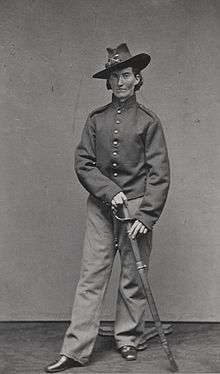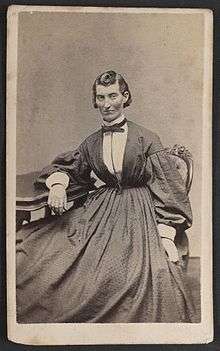Frances Clayton

Frances Louisa Clayton, also recorded as Frances Clalin, was an American woman who disguised herself as a man to fight for the Union Army in the American Civil War. Under the alias Jack Williams, she enlisted in a Missouri regiment along with her husband, and fought in several battles. She left the army soon after her husband died at Stones River.[1][2]
Newspaper reports indicate that Clayton served in both cavalry and artillery units. Her story became known and widely circulated after her service, though each account contains contradictory information about her life and service. Several photographs of Clayton, including images of her in uniform, are known to exist. However, little else is known of her life.[3]

Biography
Clayton and her husband were from Minnesota.[4] Her husband's name is not clear; one newspaper story gives it as Frank Clayton, apparently a confusion of Frances' own name, while other sources name him John or Elmer.[5] Following the outbreak of the American Civil War in 1861, the Claytons decided to enlist in the Union Army, with Frances disguising herself as a man named Jack Williams.[6]
By most accounts, they enlisted in a Missouri unit, despite being from Minnesota.[6] Clayton is said to have fought in 18 battles.[2] Sources from after the war record her as serving in both cavalry and artillery units, and indicate that she was wounded in battle; according to her subsequent statements this occurred at the Battle of Fort Donelson.[6] The same accounts describe her as a "very tall, masculine looking woman bronzed by exposure".[7] She was further able to convincingly pass as a man through her "masculine stride in walking" and "erect and soldierly carriage", as well as by adopting male vices such as drinking, smoking, chewing tobacco, swearing, and gambling.[8] In the service, she became an "accomplished horse-man" and a "capital swordsman".[9] In 1862, she fought in the Battle of Stones River, where her husband was killed during a charge. The news stories report that she did not stop fighting, and stepped over his body to continue the charge.[6]
Clayton's story only became known after her service, and was reported in several newspaper stories, though these accounts all contain contradictory information.[6] According to these stories, Clayton was discharged in Louisville in 1863, shortly after her husband's death. She told reporters that she was never discovered as a woman. She attempted to return to Minnesota before going back to the military to collect her and her husband's back pay, but her train was ambushed by Confederate guerrillas who took her money and papers. Thereafter, she traveled from Missouri to Minnesota, to Grand Rapids, Michigan, and finally to Quincy, Illinois, where a collection was held to help her on her trip. The last known report describes her heading to Washington, D.C..[6]
Several photographs of Frances Clayton are known to exist. Two were taken in Boston and are now in the possession of the Boston Public Library. One shows Clayton in women's clothing, while the other depicts her in uniform.[2][10][11]
See also
- List of wartime cross-dressers
- Deborah Sampson, impersonated a man to fight during the American War of Independence
References
- ↑ Blanton, DeAnne; Cook, Lauren M. (2002). They Fought Like Demons: Women Soldiers in the American Civil War. LSU Press. p. 10. ISBN 0807128066.
- 1 2 3 Tsui, Bonnie (2006). She Went to the Field: Women Soldiers of the Civil War. Rowan & Littlefield. p. 66. ISBN 1461748496.
- ↑ Blanton, DeAnne; Cook, Lauren M. (2002). They Fought Like Demons: Women Soldiers in the American Civil War. LSU Press. pp. 149–150. ISBN 0807128066.
- ↑ Blanton, DeAnne; Cook, Lauren M. (2002). They Fought Like Demons: Women Soldiers in the American Civil War. LSU Press. p. 150. ISBN 0807128066.
- ↑ Pride, Mike (February 21, 2016). "The unbelievable life of Frances Clayton". Concord Monitor. Retrieved September 7, 2016.
- 1 2 3 4 5 6 Blanton, DeAnne; Cook, Lauren M. (2002). They Fought Like Demons: Women Soldiers in the American Civil War. LSU Press. pp. 150–151. ISBN 0807128066.
- ↑ Blanton, DeAnne; Cook, Lauren M. (2002). They Fought Like Demons: Women Soldiers in the American Civil War. LSU Press. p. 48. ISBN 0807128066.
- ↑ Blanton, DeAnne; Cook, Lauren M. (2002). They Fought Like Demons: Women Soldiers in the American Civil War. LSU Press. pp. 52, 55. ISBN 0807128066.
- ↑ Blanton, DeAnne; Cook, Lauren M. (2002). They Fought Like Demons: Women Soldiers in the American Civil War. LSU Press. pp. 55, 58. ISBN 0807128066.
- ↑ "Frances L. Clalin 4 mo. heavy artillery Co. I, 13 mo. Cavalry Co. A. 22 months". Prints & Photographs Online Catalog. Library of Congress. Retrieved March 11, 2016.
- ↑ "Miss F. L. Clayton, 4th Mis. Arty [i.e. Missouri Artillery]". Library of Congress. Retrieved March 11, 2016.
Further reading
- Blanton, DeAnne, and Lauren M. Cook. They Fought Like Demons: Women Soldiers in the American Civil War. Baton Rouge: Louisiana State University Press, 2002. ISBN 0-8071-2806-6 OCLC 49415925
- Currie, Stephen. Women of the Civil War. San Diego: Lucent Books, 2003. ISBN 1-59018-170-0 OCLC 49529945
- Eggleston, Larry G. Women in the Civil War: Extraordinary Stories of Soldiers, Spies, Nurses, Doctors, Crusaders, and Others. Jefferson, N.C.: McFarland, 2003. ISBN 0-7864-1493-6 OCLC 51580671
- Flanagan, Alice K. Great Women of the Union. Minneapolis: Compass Point Books, 2007. ISBN 0-7565-2035-5 OCLC 226250556
- Frank, Lisa Tendrich. Women in the American Civil War. Santa Barbara, Calif: ABC-CLIO, 2008. ISBN 1-85109-600-0 OCLC 152580687
- Funkhouser, Darlene. Women of the Civil War: [Soldiers, Spies, and Nurses]. Wever, IA: Quixote Press, 2004. ISBN 1-57166-258-8 OCLC 61452250
- Hall, Richard. Women on the Civil War Battlefront. Lawrence: University Press of Kansas, 2006. ISBN 0-7006-1437-0 OCLC 62896383
- Kaufman, Will (2004). "No Non-Combatants Here: Women and Civilians in the American Civil War". Women's History Review. 13 (4): 671–678. doi:10.1080/09612020100200406. ISSN 0961-2025.
- Leckie, Robert. None Died in Vain: The Saga of the American Civil War. New York: HarperPerennial, 1991. ISBN 0-06-092116-1OCLC 24831189
- Leonard, Elizabeth D. All the Daring of the Soldier: Women of the Civil War Armies. New York: W.W. Norton & Co, 1999. ISBN 0-393-04712-1 OCLC 40543151
- Massey, Mary Elizabeth. Women in the Civil War. Lincoln: University of Nebraska Press, 1994. ISBN 0-8032-8213-3 OCLC 29520663
- Middleton, Lee. Hearts of Fire--: Soldier Women of the Civil War : with an Addendum on Female Reenactors. Franklin, NC: Genealogy Pub. Service, 1993. ISBN 1-882755-00-6 OCLC 28767147
- Silvey, Anita. I'll Pass for Your Comrade: Women Soldiers in the Civil War. New York: Clarion Books, 2008. OCLC 261505452
- Smithsonian Institution, and DK Publishing, Inc. The Civil War: A Visual History. New York: DK Pub, 2011. ISBN 0-7566-7185-X OCLC 703637353
- Tsui, Bonnie. She Went to the Field: Women Soldiers of the Civil War. Guilford, Conn: TwoDot, 2006. ISBN 0-7627-4384-0 OCLC 154202084
External links
- Outlaw Women - Women Soldiers of the Civil War includes photos of Clalin in disguise
- Disguised as a man Frances Clalin served many months in Missouri artillery and cavalry units, slide in a slideshow "Revolutionary War" part of Issues in Violence and Aggression for Health Professionals course at University Of Washington
- Women in The Civil War, Charity Post
- Female Soldiers in the Civil War.
- Women Soldiers of the Civil War.
- Covert Force.